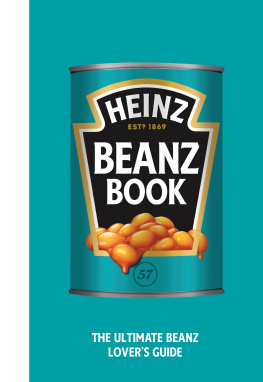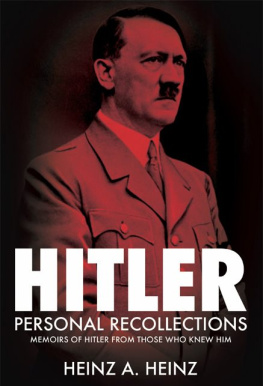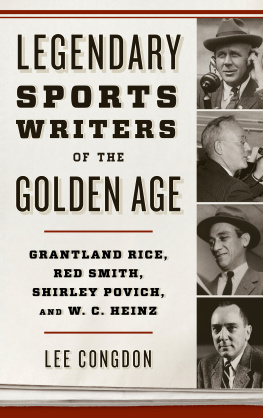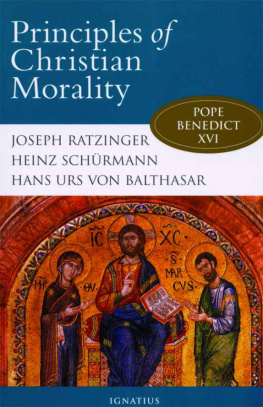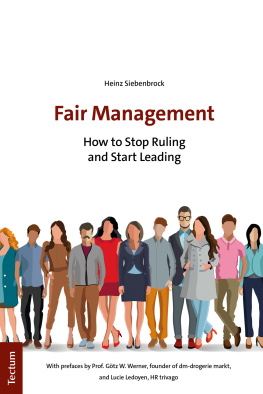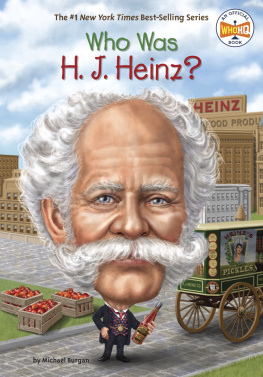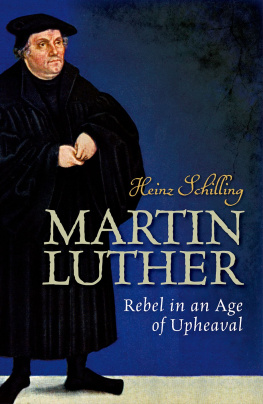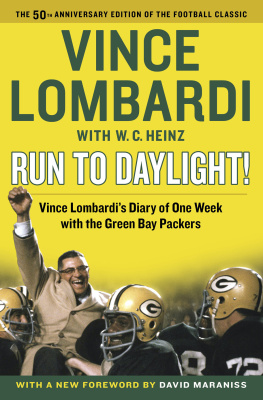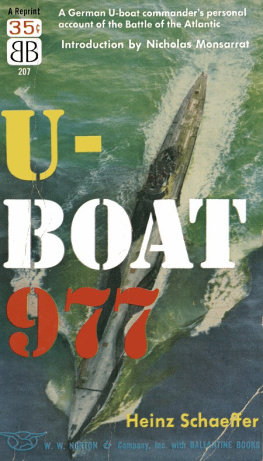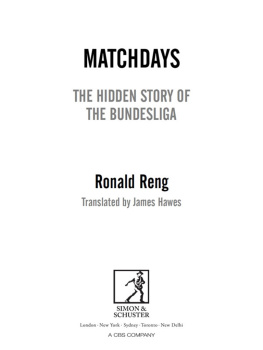
EDITED AND WITH AN INTRODUCTION BY BILL LITTLEFIELD
A SPECIAL PUBLICATION OF

THE LIBRARY OF AMERICA
Volume compilation of The Top of His Game copyright 2015 by Literary Classics of the United States, Inc., New York, N.Y. Essays by W. C. Heinz copyright 1947, 1948, 1949, 1951, 1953, 1954, 1955, 1958, 1959, 1961, 1965, 1979, 1982, 2000, 2001 by W. C. Heinz, used by permission of Gayl Heinz.
Introduction copyright 2015 by Bill Littlefield.
All rights reserved.
www.loa.org
No part of this book may be reproduced commercially by offset-lithographic or equivalent copying devices without the permission of the publisher.
Distributed to the trade in the United States by Penguin Random House Inc. and in Canada by Penguin Random House Canada Ltd.
The LIBRARY OF AMERICA, a nonprofit publisher, is dedicated to publishing, and keeping in print, authoritative editions of Americas best and most significant writing. Each year the Library adds new volumes to its collection of essential works by Americas foremost novelists, poets, essayists, journalists, and statesmen.
If you would like to request a free catalog and find out more about The Library of Ameirca, please visit with your name and address. Include your email address if you would like to receive our occasional newsletter with items of interest to readers of classic American literature and exclusive interviews with Library of America authors and editors (we will never share your e-mail address).
Book design by David Bullen
Library of Congress Control Number: 2014946643
ISBN 9781598533729 (Print)
ISBN 9781598534191 (ePub)
Contents
Autumn 1945
George M. Woolf, 19101946
Ahm Buyin Hats...
The Ascension of George Herman Ruth
DiMaggio and Louis Are Picture-Perfect Sportsmen
Hein Ten Hoff Says Ja to America
Ringside with William Jennings Bryan
Toughie Brasuhn, Queen of the Roller Derby
You Can Tell Hes All Right, He Wont Listen to Morgan
The Columbia Freshmen Are First on the River
The Yankees Send a Good Man Down
Mintz Crowned Heavyweight Manager of the World
Air Lift, Son of Bold Venture
Hooked on the Thrill of Almost Winning
Gardella Drops His Suit Against Baseball
Or, How Joe Louis Makes a Living
Al (Bummy) Davis, 19101945
GrazianoZale, September 27, 1946
Norma Graziano Gets Through the Night
Billy Graham, Boxings Uncrowned Champ
The Trouble with McNeece Is That He Fears Nothing
A Rising Marciano Lifts All Boats
Between Phone Calls with Paul Krichell
The Dodger They Padded the Walls For
Red Grange Could Carry the Ball
Gordie Howe of the Detroit Red Wings
What a Card This Pepper Martin Is!
Jim Tescher, Rodeo Rider
Theyre Dimming the Lights at Stillmans Gym
The Quiet Power of Floyd Patterson
Jim Tescher Revisited
John C. Hurley, 18971972
Joe Pages Good Days
Dancing with Willie Pep
Willie Davis Talks Vince Lombardi
Theres Only One Sugar Ray
Eddie Arcaro Rode to Win
The Life and Times of Rocky Graziano
Introduction
True to the Way It Happens
Sixty-odd years ago, the sides of the trucks delivering the New York Sun to newsstands were decorated with a large and colorful banner. The banner read:
W. C. HEINZ
Read His
Human Interest Stories On Sports
Daily In
The Sun
Buy It Today
To the left of the copy was a picture of W. C. Heinz himself, dapper in a bow tie, smiling a little ruefully, perhaps at the celebrity he had achieved. Or perhaps he was bemused that he was still alive. Hed recently returned from duty as a war correspondent in Europe. Half a century later he would talk with quiet gratitude about the soldiers whod kept him safe during World War II while he walked with them and huddled with them in foxholes and wrote about their days for readers at home.
One morning as he was crossing a Manhattan street, one of the trucks advertising his work came hurtling around the corner. W. C. Heinz, Bill to his friends, jumped back out of the street just in time to avoid becoming a sad and ironic headline on the sports page of the newspaper for which he was writing.
I got that story from Bills daughter, Gayl Heinz. She told me Bill had enjoyed telling it. Gayl is the sort of daughter all writers should have, or at least all writers who deserve to stay in print, because she has devoted a lot of energy and time to ensuring that generations of readers will have the opportunity to appreciate the work her father did.
The work that appeared in the Sun under the byline W. C. Heinz can be categorized as human interest stories in the same sense that the work of William Faulkner, Flannery OConnor, Kurt Vonnegut, and Ernest Hemingway can be so categorized.
Like Faulkner, Bill Heinz understood the significance of place. For him the place was not an imaginary county in Mississippi but a very real boxing gym on Eighth Avenue, or a racetrack in the rain, or a tavern in the middle of a clumsy hold-up.
Like OConnor, he understood that the people at the edges of any endeavor offered, by necessity, original perspectives on a culture into which they would never fit.
Like Vonnegut, he wrapped his darkest observations in humor. Often the humor was exceptionally gentle.
Like Hemingway, he never wasted a word. Hemingway recognized that quality in Heinz. When, in 1958, he was invited to comment on Bills novel The Professional, Hemingway sent a telegram in which he called it the only good novel Ive ever read about a fighter and an excellent first novel in its own right.
They were more than passing acquaintances. Both had worked as correspondents in Europe during World War II. Apparently numbers of correspondents would regularly crash at whatever house Hemingway had secured as his headquarters. On at least one occasion, Bill was one of them. According to Gayl, her father brought a bottle of scotch as a true gift of admiration for the master, in return for which Hemingway said he wouldnt allow Bill to spend the night on the floor with the others. Hemingway was prepared to give up his bed.
I couldnt, Heinz said, I wouldnt sleep a wink, and, again according to his daughter, he slept with the rest of the journalists.
As it happened, Bills visit coincided with the breakdown of Hemingways typewriter, perhaps from overwork. That night he borrowed the 1932 Remington portable Bill had been hauling around from battlefield to battlefield, and in the morning he said, That machine has a nice mill. It writes very well.
Sure, Bill said, but it writes a hell of a lot better for you than it does for me.
Heinz was wrong. The machine didnt write better for Hemingway, only differently. But the comparison serves to highlight one of the qualities that distinguish the body of work he left behind from the work of his fellow newspaper and magazine journalists. Bill Heinz wrote from the war and from the ball field and from the racetrack, the gym, and the arena. He wrote The Professional, which is more Hemingway than Red Smith, and co-wrote another novel, M*A*S*H, which provided Elliott Gould and Donald Sutherland with employment in the movies and Alan Alda with a career on TV. He also wrote about medicine and civil rights and popular culture, all of which may not be pertinent to a collection of his best sportswriting, but my point is that Heinz brought to his writing about games a wide-ranging curiosity not just about athletes but about people. They fascinated him. He took pains to capture the way they talked, the way they cheated and cherished one another, the way they did what they had to do to make it through each day without surrendering more blood or dignity than necessary.
Next page

